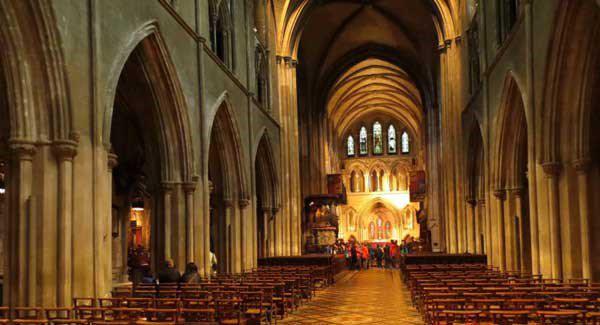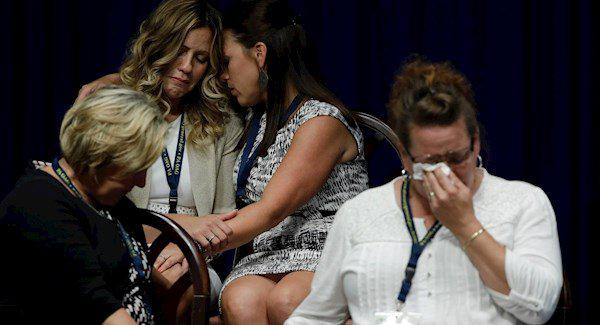|
Time for Church in US to face up to crimes
Irish Examiner
The US report on child sex abuse and cover-ups in Pennsylvania has led to calls to extend time limits for more victims to bring cases to court, writes Bette Browne. THE Pennsylvania probe of child abuse crimes and cover-ups that landed like a bombshell before the Pope’s visit here is far from over as US lawmakers fight for legal tools that would give victims more time to bring perpetrators to justice before the courts. The Pennsylvania probe of child abuse crimes and cover-ups that landed like a bombshell before the Pope’s visit here is far from over as US lawmakers fight for legal tools that would give victims more time to bring perpetrators to justice before the courts. Investigators and politicians in Pennsylvania are seeking to change time limits for prosecutions under US statute-of-limitation laws. If they succeed it will boost similar moves under way in other states, with potentially devastating consequences for the Catholic Church. Advocates for victims have been pushing to amend these statutes for some time — after the Pennsylvania revelations, their campaign has become more urgent. They want to raise the age for civil filings and to abolish or reduce time limitations on criminal charges because they want more victims to be able to seek justice. In addition to statute-of-limitation changes for criminal and civil cases, they are calling for “window” legislation that would give victims a period of one, two, or three years to file civil charges retroactively. “We strongly support these ‘look-back windows’ when civil claims can be revived,” said Anne Barrett Doyle, from research group BishopAccountability.org. “This would give older victims more time to find evidence and find witnesses to try to bring their case.” Such windows, she noted, would only apply to civil cases because in 2003 the US Supreme Court ruled that extending a criminal statute of limitation after the existing limitations period expires violates the constitution. Catholic Church authorities in the US are strongly opposing these efforts. They sought, for months, to block or delay the Pennsylvania report, with legal efforts that went all the way to the state Supreme Court. Ultimately they failed and the two-year investigation by a state grand jury, which reviewed over 500,000 internal dioceses’ documents, revealed more than 1,000 children had been abused by 301 Catholic priests in six Pennsylvania dioceses during the past 70 years. The report, released last week, implicates senior priests and bishops in knowingly moving offenders from parish to parish, as often happened in similar cases in Ireland, allowing them to continue their abuse unchecked. It makes for horrific reading, with one section describing how a group of paedophile priests marked their child victims with crucifixes. Another section details the case of a priest accused of raping a seven-year-old girl in a hospital after she had her tonsils removed. The report has triggered demands for concrete actions by the Vatican to reveal the full details of the cover-ups that facilitated the crimes and to hold those involved accountable. Catholic theologians, scholars, and lay leaders began circulating a petition after the revelations urging all 271 active bishops in the US to step down, citing the Chilean example in May when all of that country’s 31 active bishops offered their resignations after an abuse scandal. The Vatican accepted five of them. Some prominent US Catholics, including Illinois state Supreme Court Justice Anne Burke, are calling for attorneys general in more US states to follow Pennsylvania’s lead and set up grand jury probes. In Pennsylvania’s grand jury system, 23 jurors meet in private to sort through potential evidence on complicated crimes. Prosecutors say such proceedings can help develop difficult cases and bring to light issues that would otherwise remain hidden, while critics caution that the process should not be used to identify and criticise individuals who haven’t been charged with crimes. Statutes of limitations can be powerful legal protectors in a democracy. Their aim is twofold: To help maintain public safety and to protect defendants from wrongful charges. The statutes of limitations are also the reason why just two of the 301 priests named in the Pennsylvania report have been charged with crimes.
The grand jury’s report states. The statutes are set down by state legislatures, and the statutes for criminal and civil cases vary widely from state to state. The legislatures set the limitation period for most serious crimes, or felonies, at five years or less, though murder usually has no deadline. The demands for statute changes began in the aftermath of the 2002 church sex abuse investigation by the Boston Globe which found most victims did not reveal the abuse until decades later, typically when they were in their 40s. Some were subject to intimidation and others felt a sense of shame and fear at reopening wounds in public and revealing the horrors they suffered. The scandal found that cardinal Bernard Law had been directly responsible for some of the transfers of serial paedophile priest John Geoghan, which allowed Geoghan to keep abusing children with impunity. This led to Law’s resignation as Archbishop of Boston, although he did not resign his position as bishop and cardinal, going on to spend much of his time shaping policy in Rome until his death there last year. In response to the 2002 crisis, the US Conference of Catholic Bishops established a charter of procedures to deal with accused child sex abusers in the clergy, including a “zero-tolerance” policy of mandatory reporting of accused abusers. This is similar to what exists today in Ireland; we also have no statute of limitations when it comes to prosecutions for sexual offences, while time limitations in civil cases vary under a number of acts. In the years since the Boston scandal, at least 29 states have amended their prosecution deadlines so victims of child sexual abuse have more time to pursue criminal cases as adults — including 15 states that now have no cutoff for prosecuting any felony sexual assault of a minor. At present, the statute-of-limitation laws in Pennsylvania allow victims of child sex abuse to come forward with criminal allegations until they are 50 years old. The age cutoff for filing civil claims is 30. Legislators want to do away with such limits for filing criminal charges and civil suits against child sex abusers. Leading the effort in Pennsylvania is Congressman Mark Rozzi, who was himself a victim of clerical child abuse. His legislation would lift time limits for authorities to pursue charges of child sexual abuse and for those victims to sue their attackers and institutions that covered it up. Rozzi’s bill would establish a two-year window for victims to file civil claims retroactively if they are now older than the current legal age limit. When Rozzi was a 13-year-old altar boy, a priest sexually assaulted him. It took Rozzi, who says the priest spent a year grooming him with trips to McDonald’s and secretly shared beers, over 20 years to talk about the experience publicly. Rozzi, now 44, is also the driving force behind a number of bills making their way through legislatures not only in Pennsylvania but in a number of neighbouring states, including New York and New Jersey, which aim to give child sex assault victims more time to sue their assailants. The Pennsylvania Catholic Conference strongly opposes such statute-of-limitation changes and the introduction of the so-called look-back windows. These proposals, it says, would, in effect, “force the people who make up an organisation like the Catholic Church today defend themselves against a crime that was committed in their parish, school, or charitable programme years ago. It is definitely unfair to individual Catholics today whose parishes and schools would be the targets of decades-old lawsuits.” Anne Barrett Doyle dismisses such fears. “The accused would still get a fair hearing because the burden of proof will remain on the victim,” she told me.
On its website, the Catholic Conference urges Catholics in Pennsylvania to “send a message to your elected officials that it is possible to strengthen laws to give justice to childhood sexual abuse survivors without bankrupting the men, women and children who make up the Church today”. In New York, Cardinal Timothy Dolan expressed his disgust after the Pennsylvania report but made no mention of the debate on the statutes of limitations in his own state, where abuse survivors are seeking passage of the Child Victims Act. This would erase a statute that bars child sexual abuse victims from proceeding with cases once they turn 23 and would instead allow future victims to bring civil cases until they’re 50 and felony criminal cases until they’re 28. It would also give them a one-year window to retroactively file civil claims against their abusers or the Church. Back in 2012, insurance experts said in a paper presented to the Vatican that as many as 100,000 US children may have been the victims of clerical sex abuse. In the 16 years since the Boston scandal, lawsuits by abuse victims have forced dioceses and religious orders in the US to pay settlements totalling over $3bn. At least 19 dioceses have filed for bankruptcy protection. There are 32 archdioceses and 145 dioceses across the US, which has almost 70m Catholics, making up about 22% of the US population. Filing for bankruptcy does not necessarily suggest the US Catholic Church is running out of money since such filings are aimed primarily at protecting assets. “That’s what bankruptcy protection is all about,” says Anne Barrett Doyle. “The Catholic Church is an immensely wealthy organisation.”
|
.
Any original material on these pages is copyright © BishopAccountability.org 2004. Reproduce freely with attribution.



